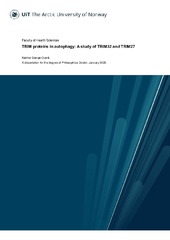TRIM proteins in autophagy: A study of TRIM32 and TRIM27
Permanent lenke
https://hdl.handle.net/10037/17399Åpne
Dato
2020-02-02Type
Doctoral thesisDoktorgradsavhandling
Forfatter
Stange Overå, KatrineSammendrag
TRIM proteins are ubiquitin E3 ligases known to be involved in a number of different processes in the cells, such as intracellular signaling, transcription, autophagy, innate immunity, cell cycle progression and DNA repair. Mutations and dysregulation of TRIM proteins are implicated in many diseases, and a number of TRIMs are described as both tumor suppressors and oncogenes. Furthermore, several TRIM proteins are found to have roles in autophagy.
We identified TRIM32 as a potential autophagic substrate in a double- tag screen including 22 different TRIM proteins. We found that the autophagic degradation of TRIM32 was selective, and that TRIM32 interacted directly with the autophagy receptors p62 and NDP52, either of which was sufficient for directing TRIM32 to lysosomal degradation. Conversely, we identified both p62 and NDP52 to be TRIM32 substrates. Mutations in the Cterminal region of TRIM32 causes limb girdle muscular dystrophy 2H (LGMD2H). The LGMD2H disease mutants were unable to ubiquitylate p62 and NDP52, and unable to undergo autophagic degradation. Moreover, we showed that reintroduction of TRIM32 in TRIM32 KO cells decreased the protein level of the sequestosome-like receptors (SLRs), while reintroduction of TRIM32 LGMD2H disease mutant did not. Furthermore, we found TRIM32 expression in TRIM32 KO cells to enhance ULK1 stability and TBK1 autophosphorylation, while the LGMD2H mutant did not. The positive effect of TRIM32 on selective autophagy was supported by the finding that mitophagy was reduced in TRIM32 KO cells, while it was restored when TRIM32 was reintroduced. These findings suggest that the pathogenic effect of the LGMD2H mutation at least partially may be due to dysregulation of selective autophagy receptors, affecting the protein homeostasis in muscle cells.
We also identified TRIM27 as an autophagy substrate. Similarly as TRIM32, TRIM27 interacted with p62 and NDP52, and its autophagic degradation was dependent on ATG7 and the SLRs. TRIM27 impaired the normal autophagic response of p62 and LC3B when the cells were stressed with plasmid transfection or mimicking of virus transfection. Interestingly, TRIM27 mRNA was significantly upregulated in breast cancer tissues compared to normal tissue, and the expression of TRIM27 in various breast cancer cell lines was inversely correlated with LC3B expression. These results may reveal a link between TRIM27 and dysregulated autophagy in breast cancer.
Har del(er)
Paper I: Overå, K.S., Garcia, J.G., Bhujabal, Z., Jain, A., Øvervatn, A., Larsen, K.B., … Sjøttem, E. (2019). TRIM32, but not its muscular dystrophy-associated mutant, positively regulates and is targeted to autophagic degradation by p62/SQSTM1. Journal of Cell Science, 132, jcs236596. Also available in Munin at https://hdl.handle.net/10037/17375.
Paper II: Overå, K.S., Bhujabal, Z., Garcia, J.G. & Sjøttem, E. TRIM32 – a putative regulator of NDP52 mediated selective autophagy. (Manuscript).
Paper III: Garcia, J.G., Overå, K.S., Knutsen, E., Bhujabal, Z., Evjen, G., Lamark, T., Johansen, T. & Sjøttem, E. TRIM27 is an autophagic substrate and putative regulator of LC3B. (Manuscript).
Forlag
UiT The Arctic University of NorwayUiT Norges arktiske universitet
Metadata
Vis full innførselSamlinger
Følgende lisensfil er knyttet til denne innførselen:


 English
English norsk
norsk
